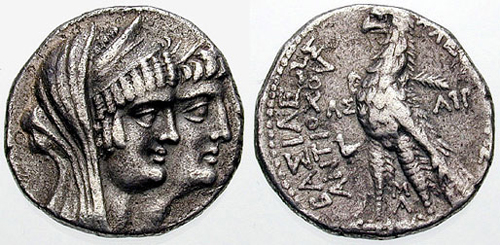S 2028 - Ascalon (Cleopatra thea & Antiochus VIII), silver, tetradrachms (123-121 BCE)
From SILVER
123 BCE - 121 BCE Silver 3,718 kg
Description
| ObverseInscription or printing placed on the obverse.: | Conjoined busts right of Cleopatra, veiled, wearing diadem and stephane, and Antiochos, diademed |
| ReverseInscription or printing placed on the reverse.: | (Greek).Eagle standing left on thunderbolt, palm over shoulder, AS and a dove left, date APP right, M/A between legs |
Mint and issuing power
| MintIdentifies the place of manufacture or issue of a numismatic object.: | Ascalon | Ancient regionAncient region.: | Phoenicia | Modern countryModern country: Israel | AuthorityIdentifies the issuing power. The authority can be "pretended" when the name or the portrait of X is on the coin but he/she was not the issuing power. It can also be "uncertain" when there is no mention of X on the coin but he/she was the issuing power according to the historical sources: | Antiochus VIII Grypus (Seleucid king, 121/0-97/6 BC), Cleopatra Thea (Seleucid queen, 150-121 BC), Seleucid Dynasty (312-63 BC) |
Chronology
| FromIdentifies the initial date in a range assigned in a numismatic context. | 123 BCE | toIdentifies the final date in a range assigned in a numismatic context.. | 121 BCE | PeriodTime period of the numismatic object.: Hellenistic 323-30 BC |
Physical description
| MetalThe physical material (usually metal) from which an object is made.: | Silver |
Median weightMedian of the weights of numismatic objects (in grams). in grams | 13.70 | DenominationTerm indicating the value of a numismatic object. Examples: tetradrachm, chalkous, denarius.: | tetradrachm |
StandardStandard.: | Ptolemaic |
Image

S2027 Ascalon Cleopatra & Antiochus VIII.jpg [1]
References
| Die study referencePublication of the study: | Voulgaridis 20001Voulgaridis 2000, p. 322-323 | ||
| Coin series referenceReference to coin series study: | |||
Reverse dies distribution
no distribution is available
Quantification
| Number of obversesNumber of obverse dies. ᵖ (o) | 7 | Number of singletons (o1)The number of singleton coins. ᵖ | 3 |
| Number of reverse diesNumber of reverse dies. (r) | 10 | Number of coinsNumber of coins. (n) | 12 |
| Coins per obverse dieNumber of coins per obverse die. (n/o) | 1.71 | Coins per reverse dieNumber of coins per reverse die. (n/r) | 1.2 |
| Reverse per obverse ratioRatio of obverse dies divided by reverse dies. (r/o) | 1.43 | Percentage of singletons (o1)number of coins (n) divided by the number of singletons (o1) ᵖ | 42.86 % |
| Original number of dies (O) (Carter 1983 formula)The estimation of the number of coins according to Carter 1983 ᵖ | 13.57 | Coins struck if 20,000 as average productivity per dieCoins made if the average productivity for obverses (according to Carter) is 20,000. ᵖ | 271,400 |
| Original number of dies (O) (Esty 2011 formula)The estimation of the number of coins according to the singleton formula in Esty 2011 ᵖ (O) | 16.8 | Survival rate if 20,000 as average productivity per dieSurvival rate if average productivity is 20,000. ᵖ | 0.00004 |
| Coverage (o = % of O) (Esty 1984 formula)Esty 1984 - coverage (% of O) ᵖ (o = % of O) | 75% | Die productivity if survival rate 1/2,000Average productivity if survival rate is 1/2,000. ᵖ | 1,768.61 |
| Weight of silver (in kg) if 20,000 coins per die (O = Carter formula)Carter 1983 * Median weight * 20000 (*10 if gold or electrum) ᵖ | 3,718 kg <br /> 3,718 kg | Die productivity if survival rate 1/5,000Average productivity if survival rate is 1/5,000. ᵖ | 4,421.52 |
Remarks
Most likely one single workstation
References
- ^ Voulgaridis, Georges (2000), Les ateliers monetaires de ptolemais-'Akko et d'Ascalon sous la domination seleucide, unpublished doctoral dissertation, Marc Bloch University, Strasbourg, 2 vol., 448 p., 37 pl.